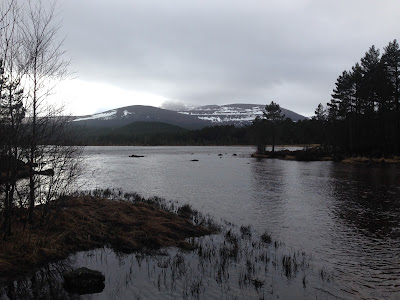Surveying for capercaillie is a bit different to most other bird surveys, in that you actually don't see the birds that often. Mostly, my survey work at the beginning of the year involved a lot of walking around forests and looking for capercaillie poo, feathers, footprints, dust baths, or any other signs that they have been using an area. Once we know where they're using, we can survey the birds! Of course, since this project has been going for many years now, we're fairly sure that we know all of the areas that have any serious activity going on in them, but you never can be sure until you've checked... Anyways, for the first month or so of my contract, this is what I was doing - walking around forests that have birds in, looking for areas where the activity it centered, so that we can come back and survey them in the lekking season, when cocks do a little display dance to attract in hens to mate with.
For capercaillie, the lek season doesn't last long at all. Black Grouse, for example, will lek for a couple of months, allowing each lek site to be counted multiple times, at least twice. Capercaillie on the other hand, lek for a couple of weeks in April. So we have to survey (an co-ordinate others to survey) all of the leks in Scotland in the space of just a few weeks. And within those weeks there is a peak of activity when all of the hens come down from the trees to be mated, before going off to nest. Unfortunately, there just isn't enough resource to visit all leks within the peak, let alone twice! But they do all get one count, and this, combined with other survey data, is good enough to get an idea of the size of the breeding population.
 |
| Lovely bit of Scots pine forest |
The lek surveys are pretty intense, having to fit so many surveys into such a small window is not easy! So we have to search the forests before-hand, so that we know we're going to the right place when it comes to the lek surveys and we don't waste valuable time wandering about. In addition to this, the birds only display very early in the morning, so our surveys involve hiking into the forest, camping overnight in a hide (pretty cold in early April!) and getting up at the crack of dawn to survey the number of males displaying and the number of females watching this display. This all requires special licences from SNH, as capercaillie are a Schedule 1 bird and highly protected under law from any disturbance while displaying, nesting, or with chicks. We take every precaution possible to ensure that the birds don't know we're there, as we want them to have a successful breeding season! So after the cocks have finished displaying, we pack up, search another area, and set up the hide again in a different forest ready for later that night! Very intense, but worth it to know how these birds are faring.
 |
| One benefit of lots of late nights and early mornings is seeing the sunrise through the trees |
That's all over now, and currently I'm working to collate all of the data from these surveys, a rather large task! Once we've got the data in we can compare it to previous years and see how the birds are doing. In addition to this, I'm visiting forests that have had capercaillie in the past, or new forests that may become suitable habitat in the future, to see if birds are starting to use and re-colonise these areas. There's a lot of woodland to check though! And hopefully there will be even more areas of forest in future years as people continue to plant up areas. Capercaillie are big birds, and they need big areas of forests (preferably Scots pine) with lots of blaeberry and boggy patches in order to survive. If we want their numbers to increase, we need to increase the area and quality of suitable habitat!
 |
| I do get to visit some beautiful places |
Although the lekking season is over for the capercaillie, it doesn't all end there. The hens should be on nests now and are very vulnerable. Even after the eggs hatch and they can move away from the nest, the hen and her chicks are vulnerable to predation, bad weather, and human disturbance. Human disturbance is a major issue that we're trying to tackle through education and information, ensuring that signs are put up in capercaillie-sensitive areas asking people to stick to the paths and keep their dogs on leads. Dogs can kill capercaillie adults and chicks, and with such a small population, we need every bird we can get! Hens can get separated from their chicks if flushed from the ground by a human presence, and won't come back to chicks if you're still in the area, making them even more vulnerable. So if you're out walking in the forests up in the Highlands (and let's face it, why wouldn't you be?), please keep to the paths and keep your dogs on a lead, and adhere to all signs regarding capercaillie. And if you see any capercaillie poo or any birds, please report it!
 |
| All in a day's work for CaperGirl! |
No comments:
Post a Comment